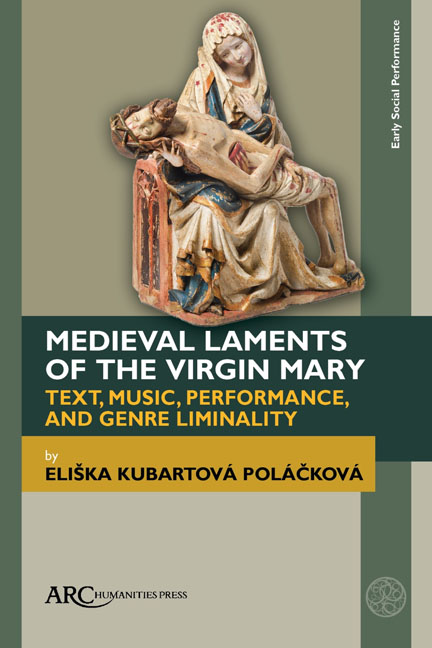Book contents
- Frontmatter
- Contents
- List of Illustrations
- Preface
- Introduction. The Suffering of the Virgin Mary as an Inner Drama
- Chapter One Marian Lament and Medieval Piety
- Chapter Two Genre, Mediality and Aesthetics
- Chapter Three Modes of Performance
- Chapter Four Bohemian Laments: Feeling Like a Woman, Thinking Like a Man. Or Not?
- Appendix: Bohemian Marian Laments — Excerpts
- Bibliography
- Index
Chapter Three - Modes of Performance
Published online by Cambridge University Press: 28 December 2023
- Frontmatter
- Contents
- List of Illustrations
- Preface
- Introduction. The Suffering of the Virgin Mary as an Inner Drama
- Chapter One Marian Lament and Medieval Piety
- Chapter Two Genre, Mediality and Aesthetics
- Chapter Three Modes of Performance
- Chapter Four Bohemian Laments: Feeling Like a Woman, Thinking Like a Man. Or Not?
- Appendix: Bohemian Marian Laments — Excerpts
- Bibliography
- Index
Summary
IN THE PREVIOUS chapters, Marian Lament has been presented as one of the dis-cursive formations of medi eval Marian devotion, closely related to affective and Passion piety, as it was cultivated by Cistercian, Franciscan, and Dominican theo logians and preachers from the twelfth century onwards all over Europe. It has also been presented as a sort of “fluid genre” overlapping substantially with other forms of medieval textual, visual, and cultural praxes, including Marian and Passion (para-)liturgical celebrations, private devotional techniques, the idiom of (the commentaries on) the Song of Songs, dramatic liturgical and paraliturgical representations, or the motivic and poetic appara-tus of courtly literature. The dialogic nature of Marian laments was identified as one of the distinct qualities that render the genre as inherently participatory, encouraging its pious target audience to experience the represented events as “real,” and, therefore, be able to deeply empathize with the Virgin Mary's experience of the suffering and death of her son, and even to imitate her attitude in feeling affectus and compassio as she did, in order to seek unification with the saviour, and, ultimately, salvation. This chapter, focusing on the ways in which the planctus Mariae could have been performed and experienced, discusses the particular ways in which the faithful recipients were enabled to partake in the drama of salvation through their own bodies, entering into direct interaction with the divine, in the figures of the Virgin and Christ, through song, speech, movement, and touch.
It has already been noted that Marian Lament existed in medi eval culture in various performative contexts. As an optional item, it may have been included in the Good Friday liturgy as a part of the Mass of the Presanctified, usually before the Reproaches (Improperia), Christ's complaints about his people that were chanted by the priest at the beginning of the mass, or during the Adoration of the Cross. As a paraliturgical item, the planctus could be included in the ceremony of the Deposition of the Cross, staged either during the Mass of the Presanctified, or, more commonly, after it, preceding or following the Vespers of the Divine Office.
- Type
- Chapter
- Information
- Medieval Laments of the Virgin MaryText, Music, Performance, and Genre Liminality, pp. 133 - 168Publisher: Amsterdam University PressPrint publication year: 2023



